<dependency>
<groupId>org.mule.modules</groupId>
<artifactId>mule-module-sharepoint-2010</artifactId>
<version>x.x.x</version>
<classifier>mule-plugin</classifier>
</dependency>Microsoft SharePoint 2010 Connector - Mule 3
Microsoft SharePoint 2010 Connector v1.0
| As of October 2020, Microsoft stopped providing support for Sharepoint 2010. See this article for more information. As a result, Anypoint Connector for Sharepoint 2010 is deprecated since the underlying technology does not have support from Microsoft. |
MuleSoft continues to support the following Anypoint Connectors to assist you with your Sharepoint integration needs:
-
Sharepoint Connector - Mule 4
-
Sharepoint Online Connector - Mule 3
-
Sharepoint 2013 Connector - Mule 3
-
Sharepoint On-Premise Connector - Mule 3
Anypoint Connector for Microsoft SharePoint 2010 (SharePoint 2010 Connector) is a web app platform for content and document management, intranet portals, collaboration, extranets, websites, and enterprise search. The connector enables integration with SharePoint 2010 through its SOAP API.
Release Notes: Microsoft SharePoint 2010 Connector Release Notes
Samples: sharepoint-2010-connector-samples.zip
Supported Operations
-
Lists and List Items API: Create, delete, retrieve, and update lists and list items
-
Files and Folders API: Create, delete, retrieve folders. Add, retrieve content, retrieve metadata, delete, check out, undo check out, check in, publish, unpublish, approve, deny, and copy files
POM File Information
If you Mavenize your Studio project, you can use this information in your project’s pom.xml file:
Replace x.x.x with the version that corresponds to the connector you are using.
To obtain the most up-to-date pom.xml file information, access the connector in Anypoint Exchange and click Dependency Snippets.
Install the Connector
-
In Anypoint Studio, click the Exchange icon in the Studio task bar.
-
Click Login in Anypoint Exchange.
-
Search for the connector and click Install.
-
Follow the prompts to install the connector.
Example Use Case
Step 1: Create a New Mule Project
Once Anypoint Studio has launched, create a new project:
-
From the menu, select File > New > Mule Project.
-
In the New Mule Project window, enter sharepoint2010-demo as the Project Name.
-
Click Finish.
Step 2: Create and Configure a New SharePoint Global Element
Configure the connector to connect to a SharePoint 2010 instance:
-
Click the Global Elements tab.
-
Click Create to bring up Global Type dialog box.
-
In the Filter text box, enter sha.
-
Select Microsoft SharePoint 2010 and click OK.
-
Fill in the required parameters. Refer to Connection Configuration for details.
-
Click Test Connection to make sure the connection works correctly.
-
Once the connection is successful, click OK.
Step 3: Create a Flow to Query SharePoint 2010
Create a Mule flow to query the "Shared Documents" List.
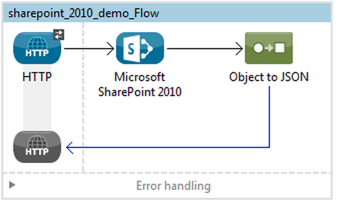
To create the Mule flow, follow these steps:
-
Click the Message Flow tab.
-
Search for http and drag an HTTP connector onto the canvas. This creates a new flow.
-
Search for sharepoint and drag Microsoft SharePoint 2010 next to the HTTP connector, on the Process area.
-
Search for json and drag an Object to JSON transformer next to the Microsoft SharePoint 2010.
-
Double-click the HTTP connector. Click the + beside the Connector Configuration list.
-
In the HTTP Listener Configuration window, set Protocol to HTTP, Host to All Interfaces [0.0.0.0] (Default) and Port to 8081. Click OK.
-
Under Basic Settings, set the Path to /query.
-
Double-click the Microsoft Dynamics SharePoint 2010 and update the following configuration values:
-
From the Connector Configuration list, select the Microsoft SharePoint 2010 configuration that was previously created.
-
From the Operation list, select List Item query.
-
From the Language list, click DataSense Query Language.
-
Click Query Builder…
-
From the list of Types, select Shared Documents.
-
From the list of Fields, select ID and Title.
-
From Order By list, select Title.
-
From Direction list, select DESCENDING.
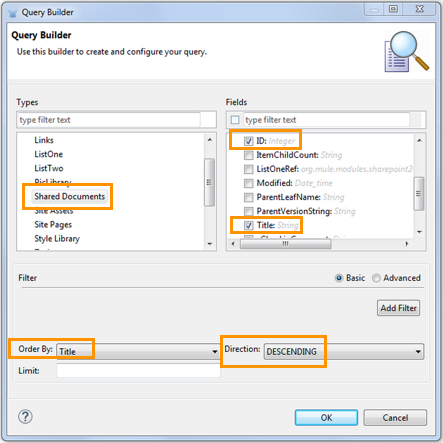
-
-
Click OK.
Step 4: Running the Flow
-
In Package Explorer, right-click sharepoint2010-demo and select Run As > Mule Application.
-
Check the console to see when the application starts. You should see the DEPLOYED message if no errors occurred.
-
Open a browser and visit
http://localhost:8081/query -
The list of documents ordered by descending file name should be returned in JSON format (results vary depending on your SharePoint instance).
[{"_ModerationStatus":"0","Editor":{"id":"8","lookUpListName":"User Information List"},"MetaInfo":"vti_parserversion:SR|14.0.0.7015\r\nvti_modifiedby:SR|i:0#.w|mule\\\\muletest\r\nListOneRef:IW|1\r\nvti_folderitemcount:IR|0\r\nvti_foldersubfolderitemcount:IR|0\r\nContentTypeId:SW|0x01010003DD4D13EF6C8446AB329E6FC42FE7BE\r\nvti_title:SW|\r\nvti_author:SR|i:0#.w|mule\\\\muletest\r\n","owshiddenversion":"2","lookUpListName":"Shared Documents","FileLeafRef":"error.txt","UniqueId":"{F0F6C9B9-6942-4866-B254-063EE8B70D59}","_Level":"1","PermMask":"0x7fffffffffffffff","ProgId":"","Last_x0020_Modified":"2015-04-09 16:21:35","Modified":"2015-04-09 16:21:20","DocIcon":"txt","ID":"1","FSObjType":"0","Created_x0020_Date":"2015-04-09 14:57:18","FileRef":"Shared Documents/error.txt"}]
Authentication Schemes
The Microsoft SharePoint 2010 connector supports the following authentication schemes:
-
NTLM Authentication
-
Kerberos Authentication
-
Claims-based Authentication
NTLM Authentication
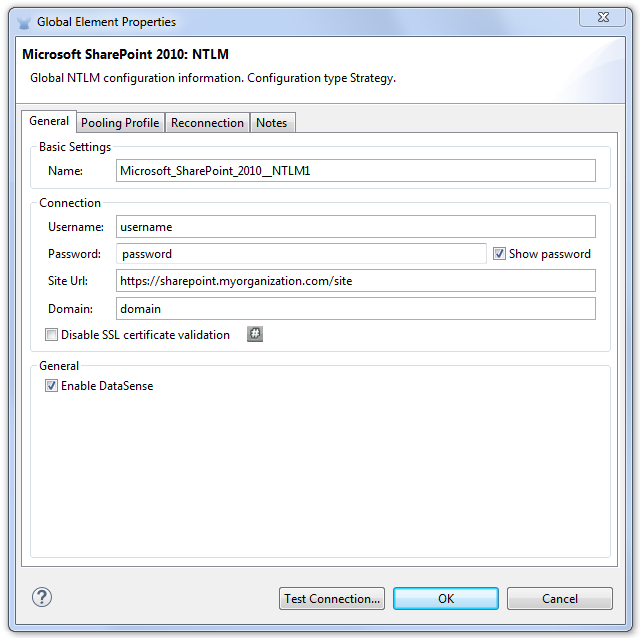
The NTLM Authentication scheme has the following parameters:
| Parameter | Description |
|---|---|
Username |
User to authenticate with. |
Password |
Password for the user to authenticate with. |
Domain |
Domain of the SharePoint instance. |
Site URL |
The path to the Microsoft SharePoint Site ( |
Disable Cn Check |
When dealing with HTTPS certificates, if the certificate is not signed by a trusted partner, the server might respond with an exception. To prevent this it is possible to disable the CN (Common Name) check. Note: This is not recommended for production environments. |
Kerberos Authentication

The Kerberos Authentication scheme has the following parameters:
| Parameter | Description |
|---|---|
Username |
User to authenticate with. |
Password |
Password for the user to authenticate with. |
Domain |
Domain of the SharePoint instance. |
Site URL |
The path to the Microsoft SharePoint Site ( |
Disable Cn Check |
When dealing with HTTPS certificates, if the certificate is not signed by a trusted partner, the server might respond with an Exception. To prevent this it is possible to disable the CN (Common Name) check. Note: This is not recommended for production environments. |
Service Principal Name (SPN) |
The SPN looks like host/SERVER-NAME.MYREALM.COM |
Realm |
The Domain that the user belongs to. Note that this value is case-sensitive and must be specified exactly as defined in Active Directory. |
KDC |
This is usually the Domain Controller (server name or IP). |
Advanced Kerberos Configuration
If the environment is complex and requires further settings, a Kerberos configuration file has to be created manually and referenced in the connector’s connection configuration.
The following parameters are available for advanced scenarios:
-
Login Properties File Path: Path to a customized Login Properties File. You can tune the Kerberos login module (Krb5LoginModule) with scenario-specific configurations by defining a JAAS login configuration file. When not specified, default values which usually work for most cases are set up. There are two options for setting this property:
-
Place the file in the class path (usually under
src/main/resources) and set the value of the property toclasspath:jaas.conf. -
Provide the full path to the file as in
C:\kerberos\jaas.conf.
-
-
Kerberos Properties File path: Path to a customized Kerberos Properties File. There are two options for setting this property:
-
Place the file in the class path (usually under
src/main/resources) and set the value of the property toclasspath:krb5.conf. -
Provide the full path to the file as in
C:\kerberos\krb5.conf.
-
JAAS Login Configuration File
Following is a sample of the JAAS login configuration file for the Kerberos login module:
Kerberos {
com.sun.security.auth.module.Krb5LoginModule required
debug=true
refreshKrb5Config=true;
};
For more information on how to create the JAAS login configuration file for the Kerberos login module, see Krb5LoginModule.
Kerberos Configuration File
Following is a sample of the content of a Kerberos configuration file:
[libdefaults]default_realm = MYREALM.COM[realms]MYREALM.COM = { kdc = mydomaincontroller.myrealm.com default_domain = MYREALM.COM}[domain_realm].myrealm.com = MYREALM.COMmyrealm.com = MYREALM.COM
Important: Realm and default_domain are case-sensitive and must be specified exactly as defined in Active Directory. Receiving an error during Test Connection stating "Message stream modified (41)" is an indication that the domain name is not correctly formed.
More information on how to create the Kerberos configuration file can be found at krb5_conf.
Claims-Based Authentication
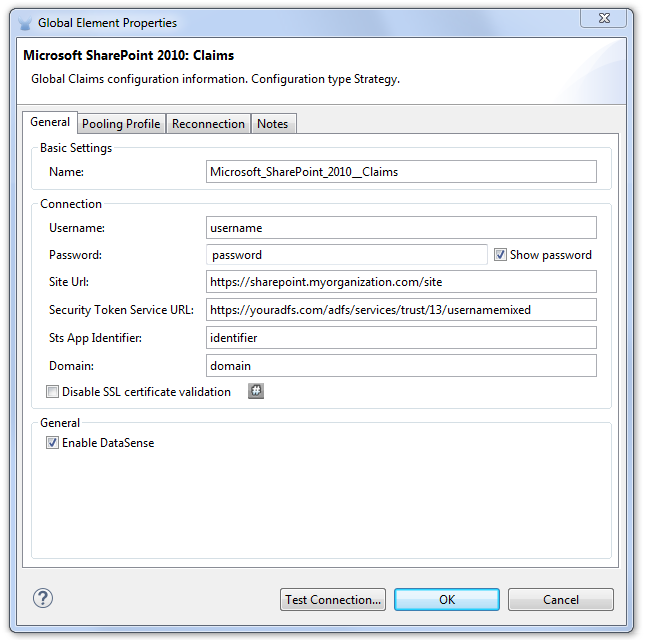
The Claims-Based authentication scheme has the following parameters:
| Parameter | Description |
|---|---|
Username |
User to authenticate with. |
Password |
Password for the user to authenticate with. |
Domain |
Domain of the SharePoint instance. |
Site URL |
The path to the Microsoft SharePoint site ( |
Security Token Service URL (STS URL) |
The STS endpoint that accepts username and password for authenticating users and understands the WS-Trust 1.3 protocol. When the STS is Microsoft’s ADFS (Active Directory Federation Services), this URL usually is: |
Security Token Service (STS) App Identifier (Scope) |
This string that identifies the SharePoint site in the STS. It is also known as Relying Party Identifier, Client Identifier, Scope or Realm. When the STS is Microsoft’s ADFS, this value can be discovered in the AD FS Management console under AD FS > Trust Relationships > Relying Party Trusts > (SharepoinP Site’s relying part properties) > Identifiers tab. |
Disable Cn Check |
When dealing with HTTPS certificates, if the certificate is not signed by a trusted partner, the server might respond with an Exception. To prevent this it is possible to disable the CN (Common Name) check. Note: this is not recommended for production environments. |
Note: The Sts App Identifier can be obtained by logging into the SharePoint site that want to be accessed by opening the Site URL in a web browser. If there is more than one authentication provider configured for the site, a drop-down lists the options. Selecting the desired STS redirects to the STS’s login page. At this point, the address bar of the web browser contains a URL that includes the following query parameters wa=wsignin1.0&wtrealm=uri%3amule%3asp80. The parameter wa tells the STS that a sign in is being initiated. The wtrealm contains the URL-encoded value STS App Identifier. In the example, uri%3amule%3asp80 is uri:mule:sp80. The unencoded value is the parameter for the connector’s configuration.
Security Token Authentication
You can use a SAML security token to log in to SharePoint. You can provide an XML body via a POST request to get the security token that you put in the Studio Security Token field.
To obtain a security token, make a POST request to https://login.microsoftonline.com/extSTS.srf with this XML body:
<s:Envelope xmlns:s="http://www.w3.org/2003/05/soap-envelope"
xmlns:a="http://www.w3.org/2005/08/addressing"
xmlns:u="http://docs.oasis-open.org/wss/2004/01/oasis-200401-wss-wssecurity-utility-1.0.xsd">
<s:Header>
<a:Action s:mustUnderstand="1">http://schemas.xmlsoap.org/ws/2005/02/trust/RST/Issue</a:Action>
<a:ReplyTo>
<a:Address>http://www.w3.org/2005/08/addressing/anonymous</a:Address>
</a:ReplyTo>
<a:To s:mustUnderstand="1">https://login.microsoftonline.com/extSTS.srf</a:To>
<o:Security s:mustUnderstand="1"
xmlns:o="http://docs.oasis-open.org/wss/2004/01/oasis-200401-wss-wssecurity-secext-1.0.xsd">
<o:UsernameToken>
<o:Username>[username]</o:Username>
<o:Password>[password]</o:Password>
</o:UsernameToken>
</o:Security>
</s:Header>
<s:Body>
<t:RequestSecurityToken xmlns:t="http://schemas.xmlsoap.org/ws/2005/02/trust">
<wsp:AppliesTo xmlns:wsp="http://schemas.xmlsoap.org/ws/2004/09/policy">
<a:EndpointReference>
<a:Address>[endpoint]</a:Address>
</a:EndpointReference>
</wsp:AppliesTo>
<t:KeyType>http://schemas.xmlsoap.org/ws/2005/05/identity/NoProofKey</t:KeyType>
<t:RequestType>http://schemas.xmlsoap.org/ws/2005/02/trust/Issue</t:RequestType>
<t:TokenType>urn:oasis:names:tc:SAML:1.0:assertion</t:TokenType>
</t:RequestSecurityToken>
</s:Body>
</s:Envelope>The response to this request contains the security token between the <wsse:BinarySecurityToken> tags.
After you have a security token, specify the token value in Studio:
-
Security token: Enter the security token you obtained.
-
Site URL: Enter your SharePoint site URL.
Lists and List Items API Operations
-
List Create
Creates a list in the current site based on the specified name, description, and list template ID.
-
List Get
Returns a schema for the specified list.
-
List Get All
Retrieves all SharePoint lists.
-
List Delete
Deletes the specified list.
-
List Update
Updates a list based on the specified list properties.
-
List Item Create
Creates a new item in an existing SharePoint list.
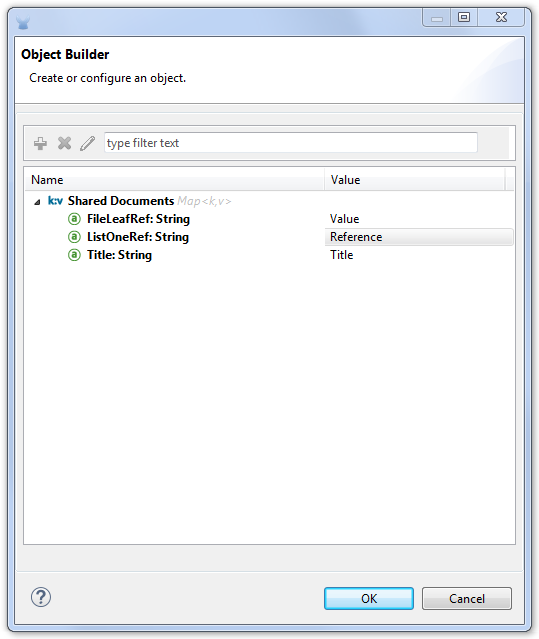
-
List Item Delete
Deletes an Item from a SharePoint list.
-
List Item Update
Updates an Item from a SharePoint list.

-
List Item Query
Executes a query against a SharePoint list and returns list items that matches the specified criteria.
Additionally to the selected fields, the following fields are always returned:
-
Created: Creation date of the item
-
FileRef: Relative URL of the file, if it is a Documents or Picture Library
-
FSObjType
-
_Level
-
MetaInfo
-
_ModerationStatus
Moderation Status of the file if it belongs to a Library that has moderation enabled:
-
Modified: Modification date of the item
-
PermMask
-
showshiddenversion
-
UniqueId
-
-
Folder Create
Creates a folder in a Document or Picture library.
-
Folder Delete
Deletes a folder from a Document or Picture library.
-
Folder Query
Retrieves all folders that matches the specified criteria.
Additionally to the selected fields, the following fields are always returned:
-
Created: Creation date of the item
-
Created_x0020_Date
-
Editor: A user
-
FileLeafRef: Name of the folder
-
FileRef: Relative URL of the folder
-
FSObjType
-
Last_x0020_Modified*
-
_Level
-
MetaInfo
-
_ModerationStatus
Moderation Status of the file if it belongs to a Library that has moderation enabled:
-
Modified: Modification date of the item
-
PermMask
-
ProgId
-
showshiddenversion
-
UniqueId
-
-
File Add
Adds a file to a Document or Picture library.
-
File Get Content
Retrieves the content of a file.
-
File Get Metadata
Retrieves the metadata of a file.
-
File Delete
Deletes a file from a Document or Picture library.
-
File Check Out
Checks out a file from a document library.
-
File Undo Check Out
Reverts an existing checkout for a file.
-
File Check In
Checks in a file to a document library.
-
File Publish
Submits the file for content approval.
-
File Unpublish
Removes a file from content approval or unpublish a major version.
-
File Approve
Approves a file submitted for content approval.
-
File Deny
Denies approval for a file that was submitted for content approval.
-
File Copy To
Copies the file to the destination URL.
-
File Query
Retrieves all files from a folder that matches the specified criteria.
Additionally to the selected fields, the following fields are always returned:
-
Created: Creation date of the item
-
Created_x0020_Date
-
DocIcon
-
Editor: A user
-
FileLeafRef: Name of the folder
-
FileRef: Relative URL of the folder
-
FSObjType
-
Last_x0020_Modified
-
_Level
-
MetaInfo
-
_ModerationStatus
Moderation Status of the file if it belongs to a library that has Moderation enabled:
-
Modified
Modification date of the item
-
PermMask
-
ProgId
-
showshiddenversion
-
UniqueId
-
Reference Objects
If you choose for a query to return either SharepointListReference or SharepointListMultiValueReference, the returned value of the field depends on the value of the Retrieve full objects for reference fields parameter:
-
Not checked: A summary object containing the reference object’s ID and the reference object list’s ID:
{ "Title": "A title", "LookupField": { "id": "1", "lookupListName": "aaaa-1111-bbbb-2222" }, "MultiValueLookupField": { "ids": [ "1", "2", "3" ], "lookupListName": "cccc-3333-dddd-4444" } }Resolve method:
Both summary objects, SharepointListReference or SharepointListMultiValueReference, make available a method called resolve.
After calling this method, the method returns the fully referenced object and replaces the summary object in the item with this resolved reference.
For example, calling the resolve method on the
LookupFieldreturns the item with ID "1" of the list with title "aaaa-1111-bbbb-2222" and the item contains:{ "Title": "A title", "LookupField": { "ID": "1", "lookupListName": "aaaa-1111-bbbb-2222" "Title": "Another title", "Property": "A property", ... }, "MultiValueLookupField": { "ids": [ "1", "2", "3" ], "lookupListName": "cccc-3333-dddd-4444" } } -
Checked: The full object that the graph retrieves.
In case there is a cycle, the summary reference object is shown:
"Title": "A title", "LookupFieldId": { "Title": "Another title", "Id": "1", Property1": "A value", ... }, "MultiValueLookupFieldId": [ { "Title": "Another title", "Id": "1", "Property1": "A value", ... }, { "Title": "Another title", "Id": "2", "Property1": "A value", ... } ] }Note: Checking this option might cause large items with many reference fields to take a long time to retrieve.



